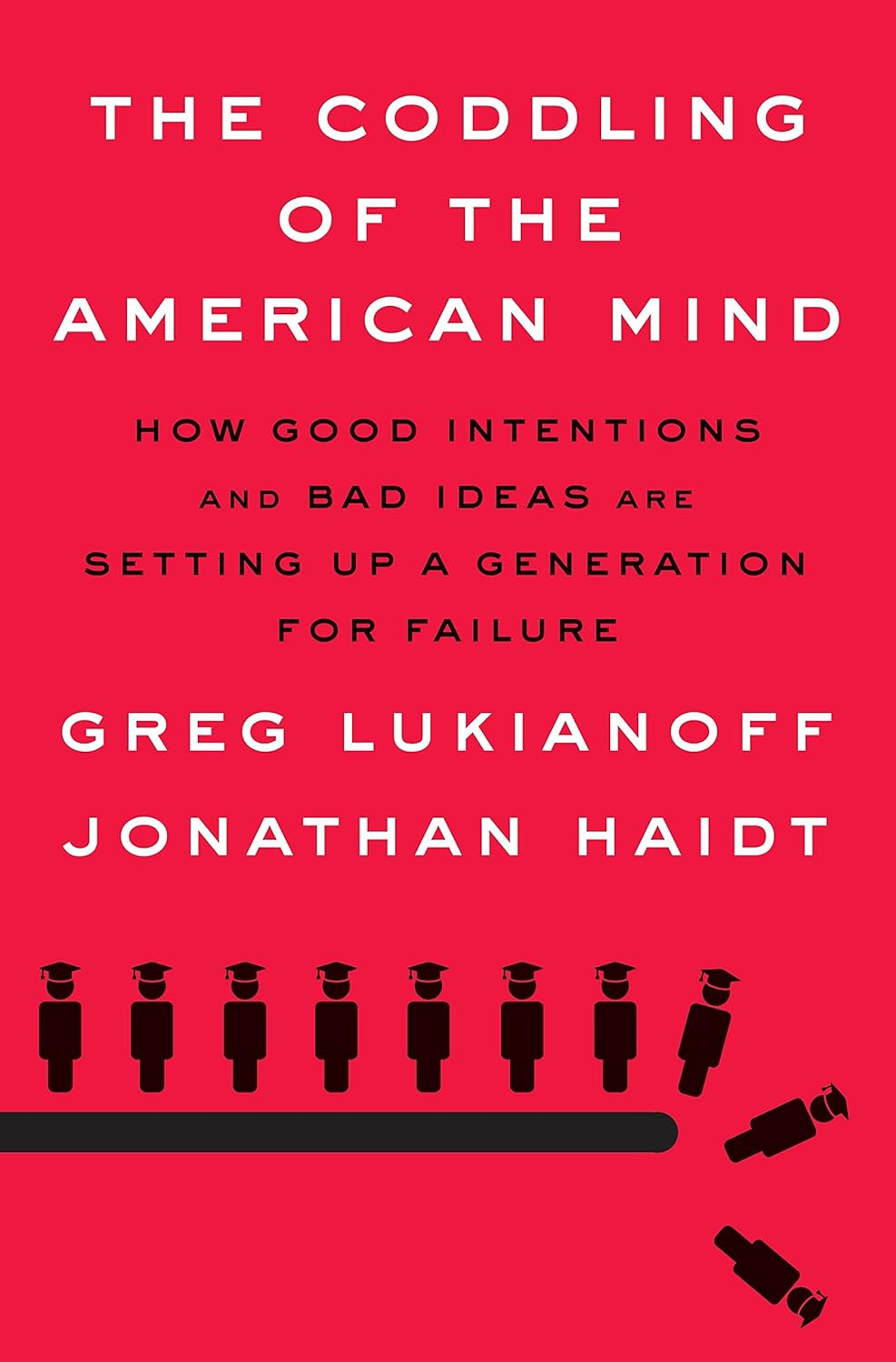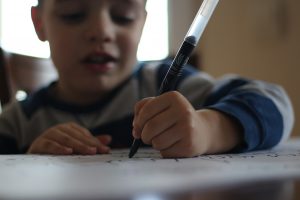Coddling of the American Mind
What 'The Coddling of the American Mind' Gets Wrong About Early Education
Young people are told to trust their feelings, that what doesn’t kill them makes them weaker and that the world can be divided into goodies and baddies.


Back in 2015, Greg Lukianoff and Jonathan Haidt published an essay in The Atlantic about the nascent American campus culture of safe spaces and no-platforming. In the intervening three years, this culture has flourished and Lukianoff and Haidt have turned their critique into a book.
The book is an interesting read and one that is strong in documenting some of the defining events of the last few years. I am less convinced of the explanation that Lukianoff and Haidt put forward for those events; an explanation they describe as a culture of ‘safetyism.’ Modern society, they claim, is teaching young people the opposite of the tenets of cognitive behavioural therapy. Young people are told to trust their feelings, that what doesn’t kill them makes them weaker and that the world can be divided into goodies and baddies.
This seems like a plausible account, even if I am no expert in the veracity of cognitive behavioural therapy. However, Lukianoff and Haidt’s explanation may underplay the extent to which campus politics is a real, if misguided, reaction to the election of Donald Trump and the rise of the kind of actual white supremacists we saw in Charlottesville (as opposed to the many imaginary ones targeted by safetyism).
While I withhold judgement on the overall argument, there is one part of the book that the authors clearly get wrong. These are the statements they make on the value of childhood play.
Lukianoff and Haidt argue that unstructured free play is essential for children to build social skills such as the ability to navigate conflict. I agree. They argue that helicopter parenting and a fear of stranger danger has caused parents to greatly reduce their children’s opportunities for free play. This is a fair point. However, they then set-up free play in opposition to any kind of early explicit teaching of academic abilities, even claiming that the latter is harmful.
Let’s examine the role of play in learning before dealing with the claim that explicit teaching causes harm.
Learning social skills is very different to academic learning. Humans have had to learn how to work together since Homo sapiens first evolved. This is what psychologist David C. Geary refers to as a ‘biologically primary’ ability and animals, including humans, have evolved play as a way of learning such abilities.

On the other hand, reading and writing, which sit at the heart of all academic abilities, have been around for just a few thousand years, with mass literacy only becoming common in the last couple of hundred years. Geary refers to these as ‘biologically secondary’ abilities. Although they co-opt primary abilities, they are something else; a cultural artefact that we have not evolved to learn through play. We can demonstrate this by pointing to the many human cultures that have not developed literacy, but where children still learn a variety of primary abilities through play.

It could be the case that play is also the best way to learn academic abilities. However, the evidence suggests that learning secondary abilities is effortful and involves an element of hard slog. Although children can learn these capabilities implicitly, it is a slow process and many more children will fail to grasp the key ideas than if an explicit approach is used.
The most obvious example is the difference between a ‘whole language’ approach to teaching early reading and systematic phonics. In whole language, children are surrounded by ‘real books,’ hear lots of stories, have plenty of choice of what to read, and are encouraged to use meaning to help predict unknown words. The relationship between the letters on the page and their corresponding sounds in speech is de-emphasised and children are expected to learn these largely implicitly. Essentially, whole language is an attempt to make early reading instruction as similar as possible to the process by which children acquire oral language; a biologically primary ability that most develop with little or no explicit teaching through a process similar to free play.
In a systematic phonics programme, the relationships between letters and sounds are taught explicitly in a planned sequence from the outset. Such lessons are often lively and engaging, with teachers working to invent routines, games and songs to keep the children’s attention, but they are the opposite of free play because the teacher is directing and explaining everything.
Three government inquiries in the United States, United Kingdom and Australia have each reviewed the available evidence and concluded that a phonics approach is superior to whole language.
The finding that explicit teaching is the most effective approach for academic learning does not, however, tell us at what age to begin, particularly if it is potentially harmful, as Lukianoff and Haidt claim. As part of their evidence, they cite a Psychology Today article that draws on research by Schweinhart and Weikart that is worth exploring in more detail.
The influence of Schweinhart and Weikart’s research is surprising. Their study began in 1967 and set out to examine how three different early education programmes impacted children into their teenage years and young adulthood. The three different education programmes included one which incorporated direct instruction (a form of explicit teaching that the children were engaged in for about an hour per day), one which was entirely play-based, and one which was called “High/Scope” (a structured play-based programme). Children from poor backgrounds were semi-randomly assigned into one of each of the three the three groups.
Schweinhart and Weikart tracked children over a period of forty years. But they were only able to trace one-third of the children who had participated in the original study, and there were significant differences between the three groups prior to intervention. For example, the number of children raised by single parents in the direct instruction group was significantly higher than the “High/Scope” group and income levels of these single-parent families were about half that of the “High/Scope” group average. Nevertheless, Schweinhart and Weikart claimed that there was a greater rate of delinquency in the teenagers who had been in the direct instruction group (amounting to a difference of about one or two teenagers) and they attributed the cause of this to direct instruction teaching methods.
Yet such an assertion of causality is surely unsupportable. It is well-known that educational effects often wash out within a year or two after the original intervention – a source of constant anguish for education researchers – and so a finding that a teaching practice adopted in preschool would substantially affect the behaviour of teenagers, ten years or so later, would be truly extraordinary.
The other evidence that Lukianoff and Haidt present is from a widely discussed but entirely unremarkable study: “The double-edged sword of pedagogy: Instruction limits spontaneous exploration and discovery,” published in authored by Bonawitz et al., and published in Cognition.
In this study, young children were given a toy to play with. Half of them had the toy demonstrated by the teacher and for the other half, the teacher pretended not to know how the toy worked and appeared to discover some of the features in front of the children. The twist is that the teacher who gave the demonstration also did not demonstrate all of the toy’s functions. Presumably, the children assumed the teacher had demonstrated all the functions because that’s what you might reasonably expect the teacher to do and so they didn’t look for the other functions. Children who had the apparently clueless teacher did discover the other functions. This is somehow presented as evidence that explicit teaching harms a child’s curiosity. It is not. Essentially, in both groups the children simply copied the behaviour of their teacher and playing with toys is a largely biologically primary activity that is remote from academic learning.

Even if explicit teaching is not harmful, it could be argued that we may still wish to delay explicit teaching in order to maximise the time for free play and for children to develop social skills. However, I think that would be a mistake. In early education settings that incorporate some explicit teaching, the majority of time is still devoted to play, something that isn’t widely understood by critics of explicit instruction who often present the choice in either/or terms.
The bigger issue around play would appear to be what is happening in the evenings and at weekends. If we delay the teaching of academic abilities, we can predict what will happen. Children from advantaged backgrounds who are surrounded by academic stimuli at home may start to pick up some academic abilities implicitly, or their parents may start explicitly teaching them. It is the children from less advantaged background who will have to wait as the gap grows wider. This does not seem like a desirable outcome.
However, I suppose Lukianoff and Haidt are not really focused on the disadvantaged. Their concern is with students attending some of the most expensive colleges in the United States. Perhaps these students have been over-parented. Perhaps they have been coddled. Perhaps they should have spent more time climbing trees as children. There might be something in that.
We just need to be careful before we apply this logic in a way that holds less advantaged children back and prevents them from gaining the academic boost that they need.






